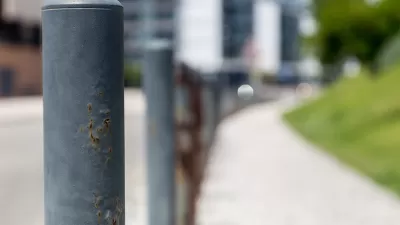Cable news networks interrupted broadcasts on Thursday morning with breaking news: a vehicle had just driven three block on the sidewalks in Times Square, New York, resulting in massive casualties. Anchors asked, "Was it terrorism or an accident?"
News hosts could initially only report on the horrific incident with graphic pictures, videos, and on-street interviews, but only speculate as to the cause, while recounting recent incidents abroad where motor vehicles had been used by terrorists to cause massive deaths and injuries.
"The speeding car jumped the sidewalk on the west side of 7th Avenue at 42nd Street and barreled into pedestrians for three blocks before crashing at the northwest corner of 45th Street," reported Ray Sanchez for CNN. "An 18-year-old woman was killed and at least 22 people injured..."
Paul Steely White, executive director of New York City-based Transportation Alternatives, takes it from here in an opinion in the Daily News published Friday.
But when news emerged that what happened in Times Square was not an act of terrorism, instead of breathing a sigh of relief, those of us in the safe streets movement could only shake our heads: It had happened again.
The driver, "Richard Rojas, 26, of the Bronx -- tested positive for PCP and told police that God made him do it, a law enforcement source told CNN," reported Sanchez. [See Planetizen: DUIDs Surpass DUIs as Cause of Fatal Vehicle Crashes.] "The Post reported that it was an attempt of "suicide by cop."
Cars jumping sidewalks and hitting pedestrians is not new. "Pedal misapplication," by definition, may not be intentional, but the effects are just as tragic and is sadly a regular occurrence. And vehicles used by deranged drivers, but not terrorists, to hit, main, and kill pedestrians and cyclists, in not new.
Yet despite this historic pattern of innocent pedestrians mowed down by drivers making deadly or sociopathic choices, and scores more throughout the rest of the city, many reporters, elected officials and first responders referred to yesterday’s tragedy — and countless others — as “accidents.”
Last year, the death toll on America's roads exceeded 40,000, according to preliminary estimates by the National Safety Council. Politifact reported in October 2015 that 24 people in the United States had died due to terrorism within the last decade.
As the final picture of Thursday's carnage, the resting place of the Honda above a steel bollard, also referred to as a stanchion, clearly illustrated, the casualty toll could have been much greater.
To prevent further loss of life, in the wake of yesterday’s tragedy we must realize that it was the controversial street safety improvements applied to Times Square in recent years — including wider sidewalks protected with steel and concrete bollards — that prevented the tragedy from being far worse.
White goes on to describe recent improvements made under Mayor Bill de Blasio in the Vision Zero program, but ends on a somber note:
It is likely that the next pedestrian death will not occur under the worldwide lens of Times Square, but on a regular street in a regular New York City neighborhood.
FULL STORY: Reckless driving, deadlier than terror

Study: Maui’s Plan to Convert Vacation Rentals to Long-Term Housing Could Cause Nearly $1 Billion Economic Loss
The plan would reduce visitor accommodation by 25,% resulting in 1,900 jobs lost.

North Texas Transit Leaders Tout Benefits of TOD for Growing Region
At a summit focused on transit-oriented development, policymakers discussed how North Texas’ expanded light rail system can serve as a tool for economic growth.

Why Should We Subsidize Public Transportation?
Many public transit agencies face financial stress due to rising costs, declining fare revenue, and declining subsidies. Transit advocates must provide a strong business case for increasing public transit funding.

How to Make US Trains Faster
Changes to boarding platforms and a switch to electric trains could improve U.S. passenger rail service without the added cost of high-speed rail.

Columbia’s Revitalized ‘Loop’ Is a Hub for Local Entrepreneurs
A focus on small businesses is helping a commercial corridor in Columbia, Missouri thrive.

Invasive Insect Threatens Minnesota’s Ash Forests
The Emerald Ash Borer is a rapidly spreading invasive pest threatening Minnesota’s ash trees, and homeowners are encouraged to plant diverse replacement species, avoid moving ash firewood, and monitor for signs of infestation.
Urban Design for Planners 1: Software Tools
This six-course series explores essential urban design concepts using open source software and equips planners with the tools they need to participate fully in the urban design process.
Planning for Universal Design
Learn the tools for implementing Universal Design in planning regulations.
Ascent Environmental
Borough of Carlisle
Institute for Housing and Urban Development Studies (IHS)
City of Grandview
Harvard GSD Executive Education
Toledo-Lucas County Plan Commissions
Salt Lake City
NYU Wagner Graduate School of Public Service




























